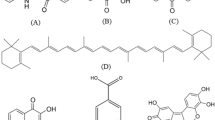Abstract
The study optimized the hydrolysis conditions for the production of fish collagen peptides from skin of Malabar grouper (Epinephelus malabaricus) using response surface methodology. The hydrolysis was done with enzymes pepsin, papain and protease from bovine pancreas. Effects of process parameters viz: pH, temperature, enzyme substrate ratio and hydrolysis time of the three different enzymes on degree of hydrolysis were investigated. The optimum response of degree of hydrolysis was estimated to be 10, 20 and 28% respectively for pepsin, papain and protease. The functional properties of the product developed were analysed which showed changes in the properties from proteins to peptides. SDS-PAGE combined with MALDI TOF method was successfully applied to determine the molecular weight distribution of the hydrolysate. The electrophoretic pattern indicated that the molecular weights of peptides formed due to hydrolysis were nearly 2 kDa. MALDI TOF spectral analysis showed the developed hydrolysate contains peptides having molecular weight in the range below 2 kDa.




Similar content being viewed by others
References
Bhaskar N, Benila T, Radha C, Lalitha RG (2008) Optimization of enzymatic hydrolysis of visceral waste proteins of Catla (Catla catla) for preparing protein hydrolysate using a commercial protease. Biores Tech 99(10):4105
Bhat ZF, Kumar S, Bhat HF (2015) Bioactive peptides of animal origin: a review. J Food Sci Technol 52(9):5377–5392
Chauhan B, Gupta R (2004) Application of statistical experimental design for optimization of alkaline protease production from Bacillus sp. RGR-14. Process Biochem 39:115–212
Gbogouri GA, Linder M, Fanni J, Parmentier M (2004) Influence of hydrolysis degree on the functional properties of salmon byproducts hydrolysates. J Food Sci 69(8):615–622
Gómez GMC, López Caballero ME, Alemán A, López de Lacey A, Giménez B, Garía Pilar M (2010) Antioxidant and antimicrobial peptide fractions from squid and tuna skin gelatin. Sea by-products as real material: new ways of application. Transworld Research Network, Signpost, pp 89–115
Huo JX, Zhao Z (2009) Study on enzymatic hydrolysis of Gadusmorrhua skin collagen and molecular weight distribution of hydrolysates. Agric Sci China 8(6):723–729
Ishida Y, Fugita T, Asai K (1981) New detection and separation methods for amino acids by high performance liquid chromatography. J Chromatogr 204:143–148
Jayathilakan K, Sultana Khudsia, Radhakrishna K, Bawa AS (2012) Utilization of byproducts and waste materials from meat, poultry and fish processing industries: a review. J Food Sci Technol 49(3):278–293
Kittiphattanabawon P, Benjakul S, Visessanguan W, Shahidi F (2012) Gelatin hydrolysate from blacktip shark skin prepared using papaya latex enzyme: antioxidant activity and its potential in model systems. Food Chem 135(3):1118–1126
Klompong V, Benjakul S, Kantachote D, Shahidi F (2007) Antioxidative activity and functional properties of protein hydrolysate of yellow stripe trevally (Selaroides leptolepis) as influenced by the degree of hydrolysis and enzyme type. Food Chem 102(4):1317–1327
Kristinsson HG, Rasco BA (2000) Fish protein hydrolysates: production, biochemical, and functional properties. Crit Rev Food Sci Nutr 40(1):43–81
Li B, Chen F, Wang X, Ji B, Wu Y (2007) Isolation and identification of antioxidative peptides from porcine collagen hydrolysate by consecutive chromatography and electrospray ionization-mass spectrometry. Food Chem 102(4):1135–1143
Nagai T, Suzuki N (2000) Isolation of collagen from fish waste material—skin, bone and fins. Food Chem 68:277–281
Ovissipour M, Abedian A, Motamedzadegan A, Rasco B, Safari R, Shahiri H (2009) The effect of enzymatic hydrolysis time and temperature on the properties of protein hydrolysates from Persian sturgeon (Acipenser persicus) viscera. Food Chem 115:238–242
Pihlanto-Leppala A (2000) Bioactive peptides derived from bovine wheyproteins: opioid and ace-inhibitory peptides. Trends Food Sci Tech 11:347–356
Rebeca BD, Pena-Vera MT, Diaz-Castaneda M (1991) Production of fish protein hydrolysates with bacterial proteases; yield and nutritional value. J Food Sci 56:309–314
Roberts PR, Burney JD, Black KW, Zaloga GP (1999) Effect of chain length on absorption of biologically active peptides from the gastro intestinal tract. Digestion 60(4):332–337
Schagger H, von Jagow G (1987) Tricine-sodium dodecyl sulfate polyacrylamide gel electrophoresis for the separation of proteins in the range from 1 to 100 kDa. Anal Biochem 166:368–379
Subhan F, Ikram M, Shehzad A, Ghafoor A (2015) Marine collagen: an emerging player in biomedical applications. J Food Sci Technol 52(8):4703–4707
Suetsuna K, Ukeda H, Ochi H (2000) Isolation and characterization of free radical scavenging activities peptides derived from casein. J Nutr Biochem 11(3):128–131
Wang L, An X, Yang F, Xin Z, Zhao L, Hu Q (2008) Isolation and characterization of collagens from the skin, scale and bone of deep-sea red fish (Sebastes mentella). Food Chem 108(2):616–623
Zague V, de Freitas V, da Costa Rosa M, Geórgia A, de Castro I, Jaeger RG, Machado-Santelli GM (2011) Collagen hydrolysate intake increases skin collagen expression and suppresses matrix metalloproteinase 2 activity. J Med Food 14(6):618–624
Zhang Y, Kouguchi T, Shimizu K, Sato M, Takahata Y, Morimatsu F (2010) Chicken collagen hydrolysate reduces proinflammatory cytokine production in C57BL/6.KOR-ApoEshl Mice. J Nutr Sci Vitaminol 56:208–210
Acknowledgements
The financial assistance for the study from Department of Biotechnology is thankfully acknowledged. Acknowledgements are also due to Director, CIFT for providing facilities to carry out this study.
Author information
Authors and Affiliations
Corresponding author
Electronic supplementary material
Below is the link to the electronic supplementary material.
Rights and permissions
About this article
Cite this article
Hema, G.S., Joshy, C.G., Shyni, K. et al. Optimization of process parameters for the production of collagen peptides from fish skin (Epinephelus malabaricus) using response surface methodology and its characterization. J Food Sci Technol 54, 488–496 (2017). https://doi.org/10.1007/s13197-017-2490-2
Revised:
Accepted:
Published:
Issue Date:
DOI: https://doi.org/10.1007/s13197-017-2490-2




